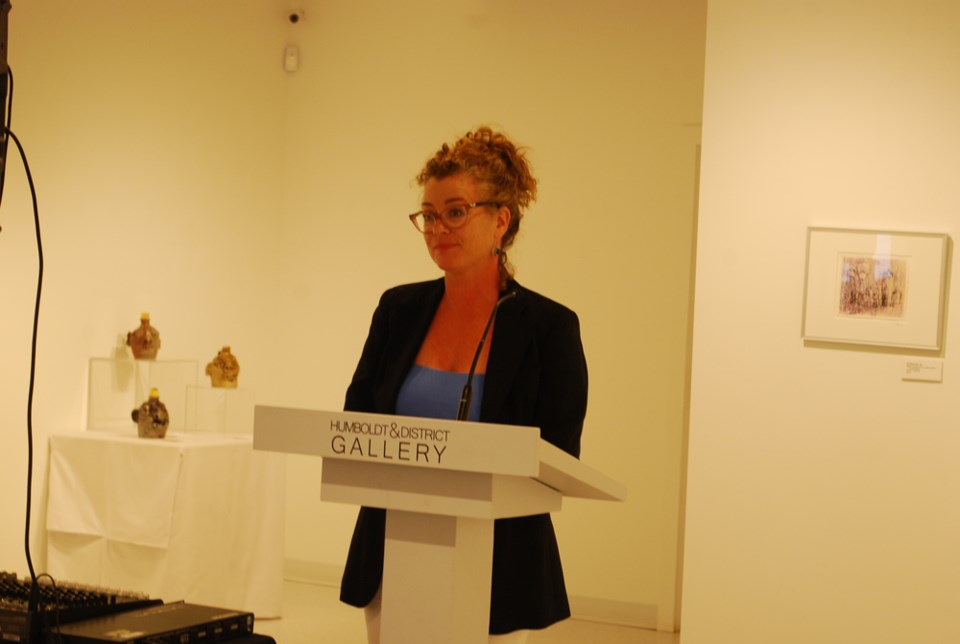Two Bonnies came to the Humboldt Gallery on July 2 to talk about the two new exhibits on display right now: Pick Up Sticks and Storybooks by Bonnie Conly and Meacham Moonshine Gang: Ceramic Face Jugs by Bonnie Gilmour.
Pick Up Sticks and Storybooks is a three-part exhibit, all centred around water towers. There are drawings, a fold out “storybook” with more drawings, and sculptures made from bamboo skewers and toothpicks.
“I have a fascination with water towers,” Conly said. “They’re like lighthouses on the prairie. When you think of a lighthouse, it’s welcoming you, it’s beckoning you, it means safety. It’s a sign of a community and that type of thing … It’s in a lot of pop culture. Corner Gas did an episode where they went up a water tower. I know a lot of people from a small town will tell you they tried to climb the water tower. We all have this fascination with it.”
It all began when she went on a trip to New York City with her daughter and saw old-style wooden water towers. The obsession grew when she started noticing towers on TV and elsewhere. She became intrigued and decided to start researching them.
“I was very pleased to find out that Saskatchewan has a very rich history of water towers,” she said.
Originally, there were 10 wooden towers built on the Prairies. Four are still standing: Humboldt, Kerrobert, Weyburn, and Kamsack. But this wasn’t enough; she wanted to know where the others were.
“I started my quest, where are all the other towers?” she said. “That whole quest to find the six remaining towers became like a game; I had to find them.”
For those interested, there were two towers in Saskatoon and the remainder were built in Watrous, North Battleford, Canora, and Moosomin.
“I wanted to know more about their stories and what happened to them,” she said. “Why is it lost, why is it no longer standing?”
Through her research, she got access to original blueprints for some of the towers. Most of her work in the exhibit is at least partially based on these. She began by drawing them, but eventually wanted to see them in 3-D, so that’s when she started making the sculptures. However, it was slow going at first. She planned to make them out of metal, but the project was too small. She settled on skewers and toothpicks, which also allowed her to manipulate the pieces more.
When she started making them, she got frustrated and put one of the sculptures aside for a bit.
“It just stayed on the floor in the corner for quite awhile,” she said, laughing. Her mentor came to the studio and noticed the unfinished project.
“She got down on her hands and knees and crawled over to the corner where my sad little piece I didn’t want to finish was and said, ‘What’s this?’” Conly said. “That’s how this all sort of came to be.”
She said her frustration with that project made her realize what it meant to have a pioneer spirit.
“You have to persevere. You have to do that sometimes with your art, keep persevering,” she said.
Bonnie Gilmour’s talk was a bit more unconventional. Her exhibit is of ceramic jugs with craggy, ugly faces and poems that tell a story about each individual face. She recited a poem and then introduced the “leader” of the Meacham Moonshine Gang: a big, mustachioed face jug.
Gilmour’s disclaimer is that any similarity to anybody living or dead is coincidental.
“I love people. I’m a people watcher,” she said. “The faces are a collage of people and faces that interest me.”
All faces are from her imagination and she doesn’t work from pictures, though she did get her husband to do some poses for her.
“‘Can you just do this to your mouth a bit? I want to see where the dimples are, how that forms, I want to see a little motion,’” she said. “He was very obliging, but got tired of it, so I started using a mirror … so I’m now making the faces.”
The poems were a natural extension of the project, and Gilmour said they sometimes came faster than the faces did. When she talks about them, she personifies them and treats them like real people.
“I like being able to look them straight in the eye and see a dialogue starting to happen. They’re talking to me. They’re telling me something,” she said.
According to Gilmour, the tradition of ceramic face jugs was to make them look scary to keep people from drinking what was inside, which was moonshine or sometimes arsenic that was used as pesticide.
“These are tame compared to the devils and the fangs and the ‘stay away from these poisons, kids!’” she said.
Gilmour lived in Saskatoon but moved to Meacham because it was more affordable to be an artist there. She misses seeing the people every day, but she said ideas are always coming to her in Meacham.
She’s been working a lot with the face jugs, either exhibiting or actually making them.
“After this is, it’s going to be like, just chill for a little bit. There’s always something going on with these. I’m having a good run with them, having a lot of fun with them, but already I’m seeing myself move to some new projects.”
While the two exhibits are not superficially similar, Conly found common ground between the face jugs and Pick Up Sticks and Storybooks.
“Hers is very much about community … I think the water tower is about community as well. Everybody can make a connection,” she said. “People have these stories … I think they both hit on community.”
Both exhibits are in the gallery until Sept. 18.




